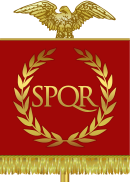
Back الجيش الروماني Arabic Exércitu romanu AST Войска Рымскай імпэрыі BE-X-OLD Древноримска армия Bulgarian Rimska vojska BS Exèrcit romà Catalan Romerske hær Danish Ρωμαϊκός στρατός Greek Romia armeo Esperanto Ejército romano Spanish
| Exercitus Romanus | |
|---|---|
 | |
| Active | 753 BC–AD 1453 (2,206 years) |
| Country | Roman Kingdom Roman Republic |
| Size | Legions: 28–50 |
| Headquarters | Aquincum Bonn Lauriacum Isca Augusta Alexandria Singara Regensburg Novae Busra |
| Motto(s) | 'Gloria Exercitus' (lit. 'Glory of the Army') |
| Engagements | See: list of Roman external wars and battles and list of Roman civil wars and revolts |
| Commanders | |
| Commander-in-chief | Emperor (de facto; 27 BC–AD 1453) Consul (de jure; 509 BC–AD 887) King (753–509 BC) |
| Notable commanders | Marcus Furius Camillus Scipio Africanus Gaius Marius Julius Caesar Germanicus Flavius Stilicho Flavius Belisarius |

The Roman army (Latin: exercitus Romanus) served ancient Rome and the Roman people, enduring through the Roman Kingdom (753–509 BC), the Roman Republic (509–27 BC), and the Roman Empire (27 BC–AD 1453), including the Western Roman Empire (collapsed AD 476/480) and the Eastern Roman Empire (collapsed AD 1453). It is thus a term that broadly spans approximately 2,206 years, during which the force underwent numerous permutations in size, composition, organisation, equipment and tactics, while conserving a core of lasting traditions.[1][2][3]
- ^ The Complete Roman Army, Adrian Goldsworthy Thames & Hudson, 2011
- ^ Companion to the Roman Army, Paul Erdkamp, John Wiley & Sons, 31 March 2011
- ^ Southern, Pat (2007). The Roman Army: A Social and Institutional History. Oxford University Press. ISBN 978-0-19-532878-3.